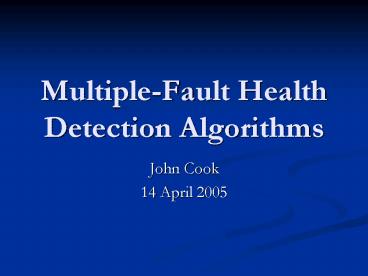MultipleFault Health Detection Algorithms PowerPoint PPT Presentation
1 / 19
Title: MultipleFault Health Detection Algorithms
1
Multiple-Fault Health Detection Algorithms
- John Cook
- 14 April 2005
2
Problem
- When multiple sensors in an ISHM system indicate
an error, there may be a root cause for this
problem. - This root cause can be isolated by constructing a
rule set or database to examine the sensor data
at a systemic level.
3
Solution Requirements
- Algorithm needs to be located above the sensor
level - Algorithm should be modified whenever a new
problem is identified - Algorithm should have access to good sensor data
4
Sensor Issues
- number
- location/placement
- dependencies
- derived parameters
5
Types of Errors
- Localized
- Upstream
- Downstream
- Unknown
6
Localized Errors
- Occur when a specific component of the
application breaks - All sensors on that part of the application give
erroneous readings - Usually can be resolved by fixing one component
7
Upstream Errors
- Caused when an error in one component affects
other components in sequence behind it - These errors can be detected by knowing the
dependencies of system components
8
Downstream Errors
- Caused when an error in one component affects
other components in sequence after it - Detection scheme similar to upstream errors
- A fault can cause an upstream and downstream
error to happen simultaneously
9
Unknown Errors
- A specific set of conditions may not be found in
either algorithm. - An error message will be returned stating that an
unknown error has occurred among certain related
sensors.
10
Fixing Unknown Errors
- Human intelligence is typically needed to find
the real cause of such a problem. - When the root cause is isolated, the algorithm
can be updated to reflect this event
11
Communication with G2
- G2 sends the sensor data to MATLAB
- MATLAB receives the data as a vector
- After processing, MATLAB returns a text message
to G2 stating the algorithm output
12
Approaches
- 2 types of algorithms
- Rule-based
- Rules made to relate sensor errors to a root
cause - Database
- Correlation of sensors to error messages and
dependencies - Algorithm will run each time a new set of sensor
data is received
13
Rule-Based Algorithm
- Rules will be implemented in MATLAB
- Rules will be a series of if-then or case
statements inside a while loop
14
Rule Advantages
- Code executes quickly
- Easy-to-read code
- Can be edited quickly
15
Database-based Algorithm
- Database is a look-up table
- Given a certain combination of inputs, the
database returns an error message if applicable
16
Database Advantages
- Database approach is more organized
- Database size grows more slowly than rule-based
structure
17
Implementation Issues
- Algorithm is system-dependent
- Algorithm is only as good as the database
- Sensor placement affects algorithm performance
18
Your Turn
- Below is the diagram of a Rankine steam cycle
- Devise a sensor placement scheme and use a method
to isolate 3 multi-sensor faults
19
The End
- Questions?

